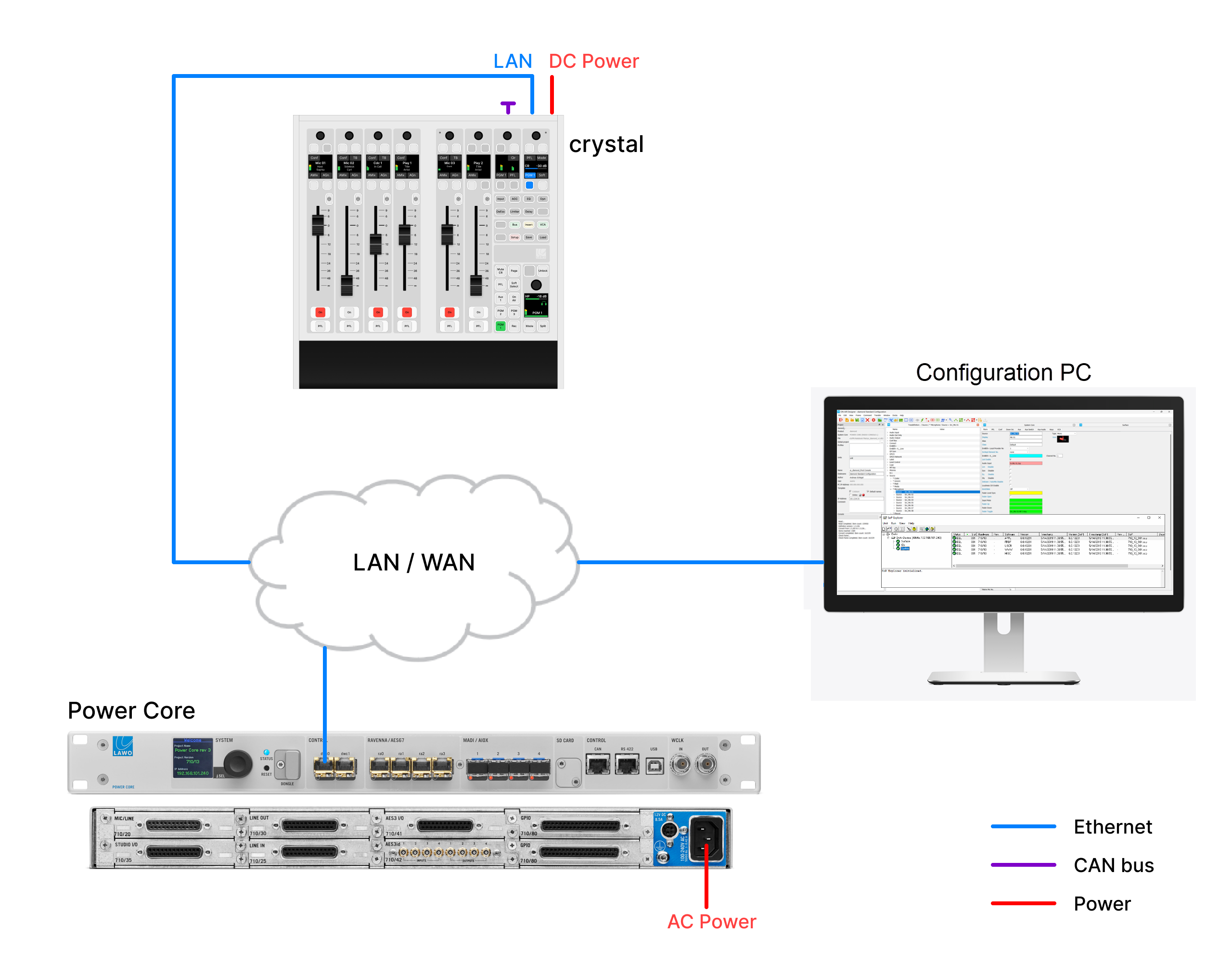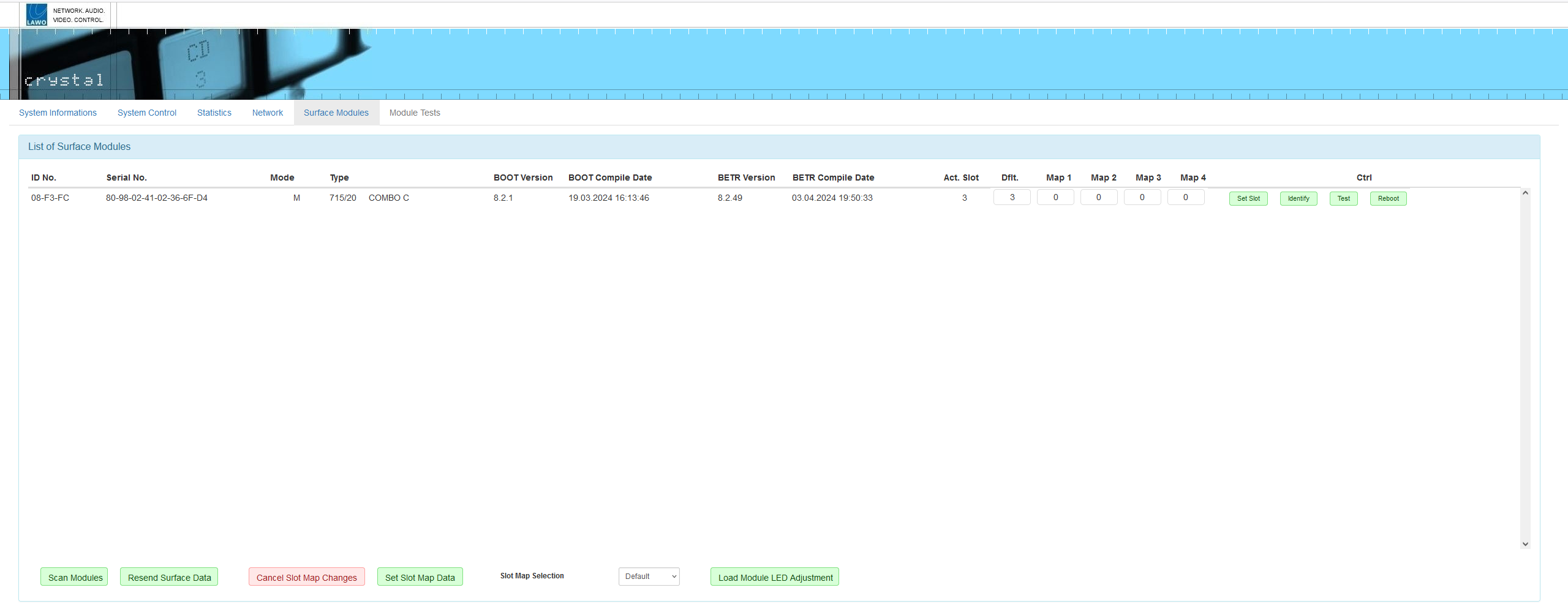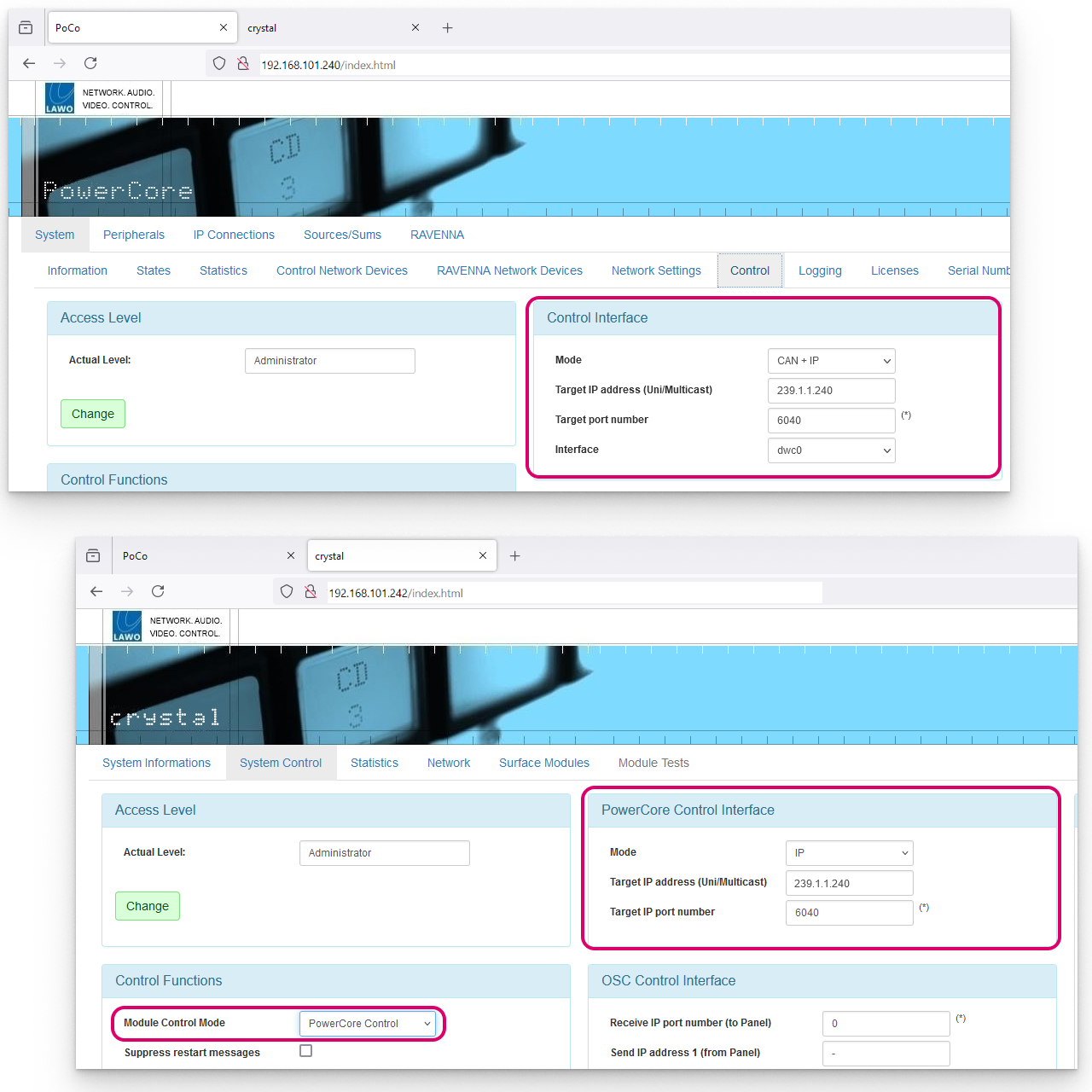crystal - Setup Instructions
This topic describes how to setup a crystal surface to operate with Power Core.
Prerequisites
The connection between the surface and Power Core must be made via TCP/IP Ethernet, either directly or via a network (LAN or WAN).
When connecting via a network, it is expected that all switches/routers meet the control network requirements described here.
If the crystal surface consists of two frames, then you will need to decide how to connect the second frame: either via CAN bus (to the main frame) or via IP (to the network).
The IP connection(s) to Power Core may use either a Multicast or Unicast IP address scheme. If you wish to use Unicast IPs for more than one frame, then this requires some additional configuration (in the ON-AIR Designer).
Requirements
Please make sure that you have all necessary applications and tools available before you start.
To set up the system, you will need a PC with a network interface card (NIC). The PC must be installed with Lawo's ON-AIR Designer software and a suitable web browser. How to prepare the configuration PC is described later in crystal - Configuration Tools.
To setup the crystal frame, you will need:
- 1 x desktop power supply (485-1209-000) - to power the frame.
- 1 x 2m IEC power cable (country-specific) - to connect mains to the desktop power supply.
- A network connection between the surface and Power Core - either via a network switch or point-to-point.
If the frame includes a VX module, then the following items are also required:
- 1 x desktop power supply (485-1209-000) - to power the VX display.
- 1 x 2m IEC power cable (country-specific) - to connect mains to the desktop power supply.
- Windows 64-bit host PC - to run the Lawo GUI application VisTool. This can be the same PC as used for the configuration software.
- 1 x Display Port cable - to connect the VX module to the host PC.
- 1 x USB cable - to connect the VX module to the host PC.
Please refer to the crystal Packing List for information about what is included with the shipment.
Connections
To boot and configure the system, the following connections must be made:
- The crystal frame must be grounded.
- The crystal frame must be connected via Ethernet to the network/Power Core.
- The crystal frame and Power Core must be powered.
The Ethernet connection can be made directly (point-to-point) but it is more usual to connect via a network (as shown below).
- To connect the crystal frame, use the ETHERNET port (on the rear of the frame).
- To connect Power Core, it is recommended to use the first control port: dwc0.
For more information about the connectors and cabling requirements, see crystal - Wiring and Power Core - Wiring.

Important: The CAN A port on the crystal frame must be fitted with the terminator (provided), unless you are linking another frame.
Boot-Up
Once power is applied, the system boots in a few seconds:
- On the surface, the displays show information about the surface module and then, after a few seconds, the Lawo logo.
- On Power Core, the boot-up progress is shown on the front panel display.
While the crystal frame is booting up, check the communication mode shown on the surface module. There are three possible options: IP+CAN, CAN or IP.
- The IP mode should be used if there is a single module connecting to Power Core (via IP).
- The IP+CAN and CAN modes can be used if you are connecting a second frame using an external CAN bus cable. In this instance, choose IP+CAN for the first frame and CAN for the second frame.
The image below shows the communication modes (in pink) for each option.

If you need to reset a module's communication mode, then this can be done from the surface. See crystal - Communication Modes.
Configuration
1. Start the configuration by connecting your PC's LAN port directly to the crystal frame.
This is done using the frame's ETHERNET port.
2. Configure the network settings for the frame's IP module.
This step is necessary if you wish to fit crystal into an existing network OR install more than one device (to avoid IP conflicts).
The settings are edited by opening a Web UI connection to the frame and adjusting the parameters in the "Network" tab.
- The Web UI can be reached by entering the current IP address. The default IPs are:
- 192.168.101.242 (for a Main module),
- 192.168.101.243 (for a Fader module).
- Log in as either Supervisor or Administrator. The default passwords are orion for Supervisor and hydra for Administrator.
- Open the "Network" tab and enter the required network settings.
The following fields can be edited: IP Address, Network Mask and Gateway. Type in the new value(s) and select Apply to save the changes.

At this stage, you can reconnect your devices via the control network OR continue on (if you plan to connect the frame directly to Power Core).
It is recommended to check the network connection to your configuration PC by re-opening the crystal Web UI.
3. Configure the surface module(s).
This step ensures that the correct slot ID is assigned to the surface module(s) and that all modules are known to the IP module (if there is more than one frame).
Start by opening the "Surface Modules" tab in the crystal Web UI. Here you will see a list of all modules in the surface. If the list is empty, press the Scan Modules button (at the bottom of the page).

The Mode column can be used to identify the master (M) and slave (S) modules.
- The master (M) is the module that connects to Power Core via IP.
- The slaves (S) are all modules that are connected to the master via high-speed CAN.
For a single-frame surface, you will see one master module (M).
For a split-frame (14-fader) surface, where the second frame is connected via CAN, you will see two modules: one master (M) and one slave (S).
Please note: If the two frames connect individually to Power Core via IP, then each frame has a single master module which is addressed separately (via its own IP address).
If you need to reset a module's communication mode, then this can be done from the surface. See crystal - Communication Modes.
The Act. Slot column shows the module's active slot ID. This is important as it determines the functionality of the module (as explained later).
During the initial setup, you should use the Dflt value to assign the correct slot ID to each physical module.
- Start by entering the required slot ID into the Dflt field - the edited value and Set Slot button highlight in yellow.
- Press Set Slot to make the assignment.
- Wait for the Act. Slot field to update and check its value.
- Repeat these steps for each module.
Note that the alternate mappings (Map 1 to 4) can be used to change the slots ID during operation. For now, it is recommended to leave these values at 0.
4. Check the control mode for the surface.
This step ensures that the frame is configured to communicate with Power Core (and not with a OSC device).
Open the "System → Control" tab in the crystal Web UI and check the Module Control Mode option (under "Control Functions"). This must be set to PowerCore Control.
If OSC Control is selected, then change the option (from the drop-down menu) and click on Reboot System (to switch the mode).
5. Configure the IP connection between the surface and Power Core.
This is done using the "Control Interface" parameters stored on each device.
To check or edit the settings, open a Web UI connection to both the crystal frame and Power Core, and log in as either Supervisor or Administrator. Then look for the "Control Interface" parameters (in the "System → Control" tab).
It is important to check both sides of the connection, so open a separate browser window for each device. In crystal, the parameters are labelled "PowerCore Control Interface" (to distinguish them from the "OSC Control Interface").
The Mode must be set to CAN+IP in Power Core and either IP or CAN+IP in crystal. (The CAN+IP option should be used if there is a CAN bus connection to a second frame.)
The Target IP address determines the IP address scheme.
- To use Multicast, the Target IP Addresses in Power Core and crystal must be identical. So, enter a suitable IP address group in Power Core and then copy it to crystal. The default setting is 239.1.1.240
- To use Unicast, you must enter the reciprocal IP addresses. So, enter the crystal control port IP address (in Power Core) AND enter the Power Core control port IP address (in crystal).
The other fields can be left at their default values.
If you make any changes to the "Control Interface" settings, then you must reboot the device(s).
The screenshots below shows an example of a multicast configuration using the default multicast IP address group.

If everything is correctly connected and configured, the surface synchronizes to Power Core once the IP connection is made.
Connecting a Second Frame (via CAN)
For a split-frame (14-fader) surface, where the second frame is connected via CAN, follow the steps above to setup the first frame.
In step 5, set the crystal Mode to CAN+IP (to support a CAN bus connection to the second frame) and reboot the surface.
Then use a CAT 5e cable to connect CAN A on the first frame to CAN A on the second frame. In this instance, the CAN bus is terminated automatically and so you can remove and store the terminators provided.
Important: The CAN A cable length must not exceed 13 meters.
If everything is correctly connected and configured, the surface synchronizes to Power Core once the IP connection to the first frame is made.
Connecting Two Frames (via IP)
If you wish to connect more than one frame via IP, then each frame must be configured separately.
In step 5, set the crystal Mode to IP (for each frame) and choose the IP address scheme as follows.
- To use Multicast IPs, the Target IP address fields in the "Control Interface" settings must be identical.
- If you wish to use Unicast IPs, then this requires some additional configuration (in the ON-AIR Designer). More information will follow.
Take care to check each of the crystal IP frames and Power Core by opening a Web UI session to each device. Remember to reboot the devices if you make changes to the "Control Interface" settings.
For the wiring, when frames are connected via IP, there is no need for an external CAN connection and so the CAN A ports must be terminated (using the terminators provided).
If everything is correctly connected and configured, each frame synchronizes independently to Power Core, This happens as soon as each IP connection is made.
Connecting KSC or GPIO Panels
The CAN B port can be used to connect one or more KSC or GPIO panels in a daisy-chain manner.
- The first connection must be made from an Ethernet frame (connected to Power Core via IP).
- In total, the CAN B cable length must not exceed 60 meters.
- On the last KSC/GPIO panel in the chain, you must fit the CAN bus terminator (provided).
Next Steps
Once the IP connection to Power Core is established, the basic setup of the crystal surface is complete.
The next steps are to check the software version(s) running on the hardware components, activate the license(s) and upload a configuration. These are done in the same way as for any other Power Core system, so please follow the links below for more information.
- Start by using SoP Explorer to upgrade Power Core to the required software release. See Power Core - Updating the Firmware.
- Activate the software license(s) using the online license portal. The license(s) must be installed onto the USB memory stick that connects to the Power Core DONGLE port. See Power Core - License Activation.
- Using ON-AIR Designer, create a crystal configuration and export it to Power Core (via "Transfer Config to Unit"). The configuration does not have to be the final version, but should define the correct surface layout and main license package. See Power Core - Uploading a Configuration.
- Return to SoP Explorer and check that it can see the surface.
- Finally, use SoP Explorer to check the status of the surface components. If upgrades are required, run the "Software Update Wizard" until all surface components are shown in green.
Important: When preparing the system configuration, it is important that the configured options match the licensed feature set. Otherwise, if the license limits are exceeded, the Power Core alarm will sound.
Once you have completed the steps above, the system is ready for operation.
You can use the "Surface Modules" tab (in the crystal Web UI) to check the status of the individual modules.
Then go to crystal - Operation to learn more about the functionality of the device.
Troubleshooting
This message appears if there is a problem with the network connection to Power Core.
- Check the network cabling and IP addresses of the surface and Power Core.
- Check the "Control Interface" settings in both the surface and Power Core.
- Check that the Module Control Mode (in crystal) is set to PowerCore Control (and not OSC Control).
- Check that the module above the frame's connector board is fitted correctly, with all screws tightened. If the screws are not fixed properly, then the module may not be plugged fully into the connector board underneath. This can lead to an intermittent network connection.
Further Information
The rest of this chapter covers the setup tasks in more detail.